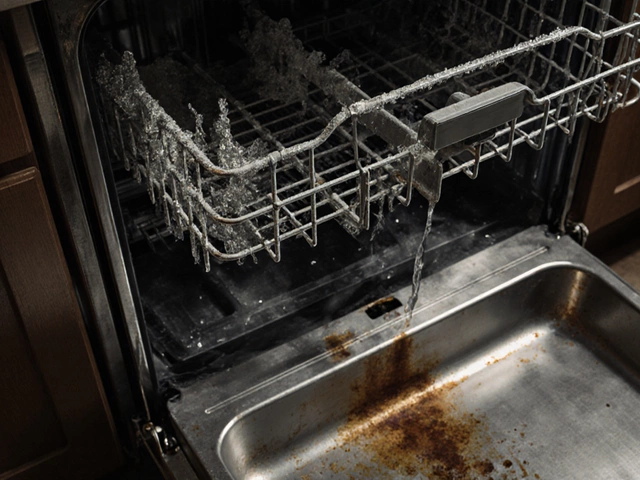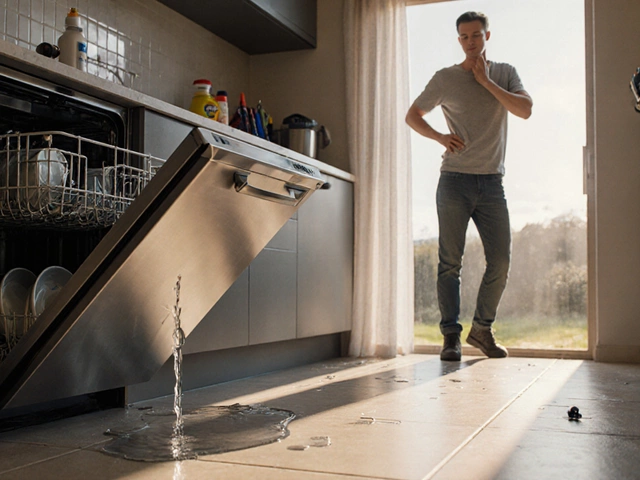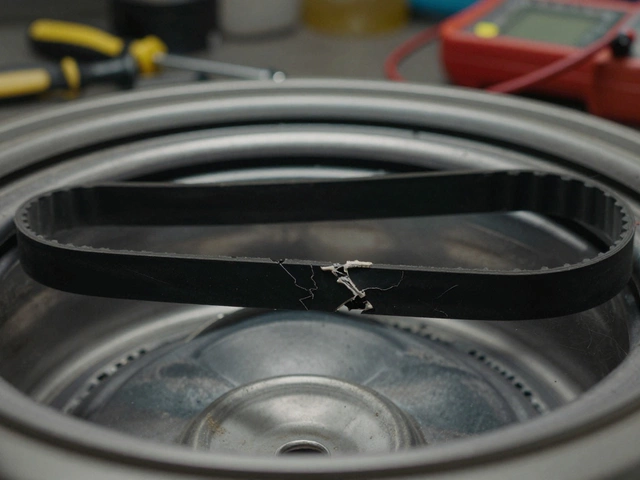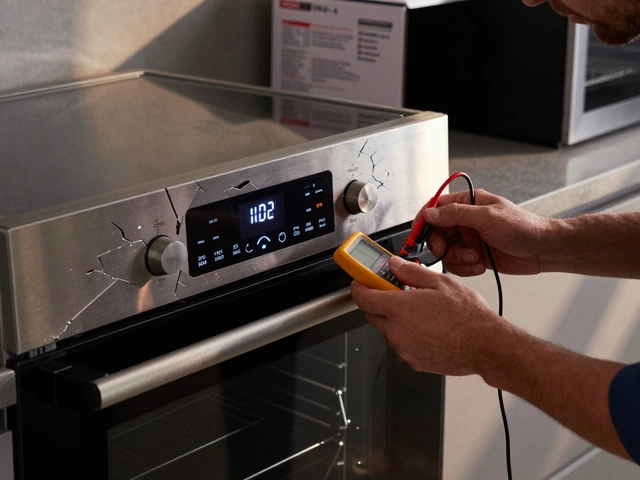Dishwasher Troubleshooter
What's happening with your dishwasher?
Select your main issue:
Your diagnosis:
Next steps:
If your dishwasher is making strange noises, leaving dishes dirty, or just won’t start at all, you’re not alone. Most people assume it’s time to call a repair tech or buy a new one-but often, the fix is simple. You don’t need to be a technician to figure out what’s wrong. With a few basic checks, you can pinpoint the issue in under 30 minutes and save yourself a service call.
Check the power first
Before you dig into hoses or pumps, make sure the dishwasher is actually getting electricity. It sounds obvious, but a tripped breaker or a loose plug is the number one reason dishwashers seem to die suddenly. Start at the circuit breaker panel. Look for the label that says "Dishwasher" and flip the switch off and back on. If it trips again right away, there’s a short circuit-don’t keep resetting it. Call a pro.If the breaker’s fine, check the outlet. Plug in a hairdryer or phone charger to test it. If nothing works, the outlet might be controlled by a wall switch. Some kitchens have a switch near the sink that turns off the dishwasher outlet for safety. Make sure it’s flipped on.
Also, check the door latch. Dishwashers have a safety switch that stops them from running if the door isn’t fully closed. If the latch is broken or the door is warped, the machine won’t start. Try pressing the door firmly shut while hitting the start button. If it runs then, the latch needs replacing.
Look for leaks or standing water
A puddle under the dishwasher is one of the most common complaints. Leaks can come from several places: the door seal, the water inlet valve, or the drain hose.Start by pulling the dishwasher out slightly (unplug it first) and checking the bottom. If water is pooling under the unit, the problem is likely internal. If it’s only leaking when the cycle runs, it’s probably a hose or seal issue.
Inspect the rubber door gasket. Over time, it gets stiff, cracked, or covered in food gunk. Clean it with vinegar and a toothbrush. If it’s brittle or torn, replace it. A bad gasket can leak even if the door looks closed.
Check the drain hose. It should loop up high under the sink (called an air gap) to prevent dirty water from flowing back in. If it’s kinked, crushed, or disconnected, water won’t drain properly and will spill out. Tighten the clamps and make sure the hose isn’t pinched against the wall or cabinet.
Is the dishwasher cleaning properly?
If your dishes come out grimy, it’s rarely the dishwasher’s fault-it’s usually how you load it or what you’re putting in it.First, check the spray arms. They spin to shoot water at your dishes. If they’re clogged with food bits or mineral buildup, they won’t reach everything. Remove them (they usually twist off) and rinse under warm water. Use a toothpick to clear the tiny holes. If they don’t spin freely when you blow air through them, they’re damaged and need replacing.
Next, look at the filter. Most modern dishwashers have a self-cleaning filter, but they still need manual cleaning every few weeks. Remove the bottom rack and find the filter at the base of the tub. Twist it out, rinse off the gunk, and put it back. A clogged filter is the #1 reason for poor cleaning performance.
Also, check the detergent. Powder or pods work best. Liquid detergent can cause sudsing that tricks the machine into thinking it’s full of foam and stops the cycle. Don’t overload the dispenser. And never use regular dish soap-it creates too many bubbles and can damage the pump.
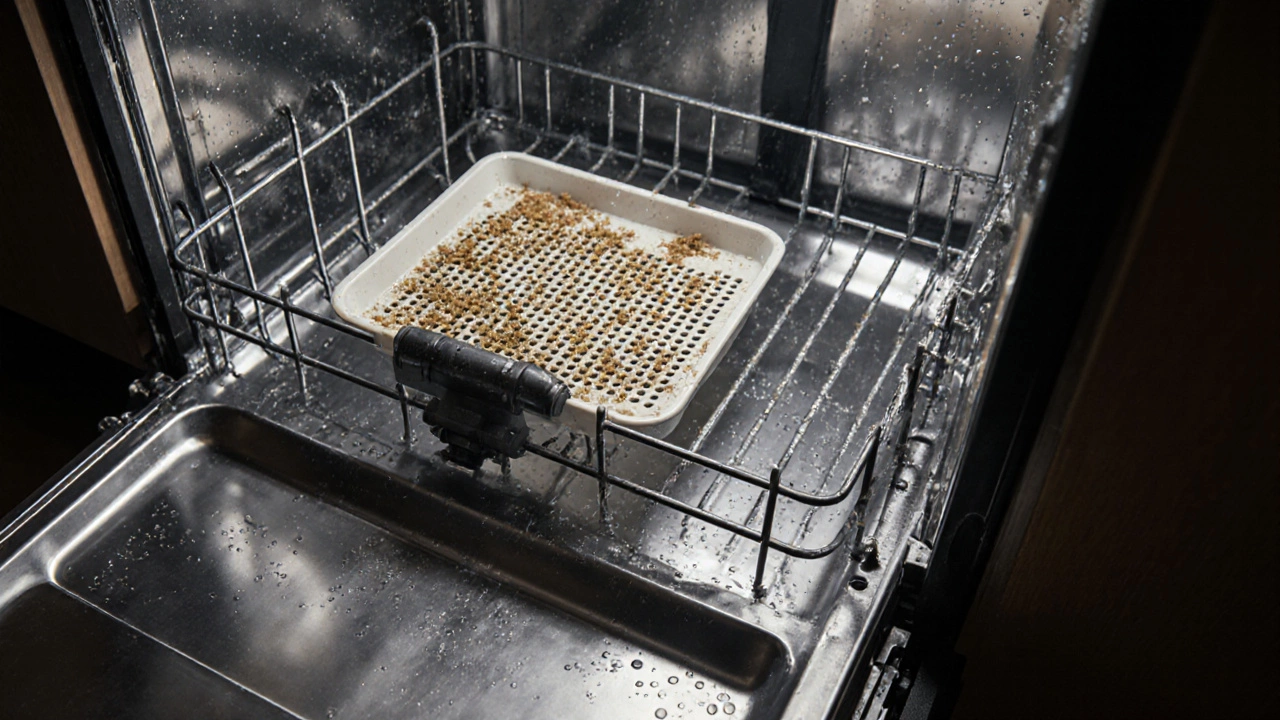
Why won’t the dishwasher drain?
If water stays in the tub after a cycle, the drain system is blocked. This is often caused by food debris, not a broken pump.Start with the drain hose. Make sure it’s not kinked or crushed. Then check the connection to your garbage disposal. Many dishwashers drain into the disposal. If the disposal is clogged or the knockout plug (a small plastic piece inside the disposal inlet) wasn’t removed during installation, water can’t flow out. Run the disposal and check for blockages.
If the disposal is clear, the dishwasher’s own pump might be jammed. Remove the bottom rack and look for large food particles or even a piece of silverware stuck in the pump area. Use needle-nose pliers to pull it out. Don’t reach in with your fingers-there are sharp blades under there.
If the pump is clear and the hose is fine, the drain solenoid (a small valve that opens the drain path) might be faulty. It’s harder to test without a multimeter, so if you’ve ruled out everything else, it’s time to call a repair technician.
Is the dishwasher making noise?
Unusual sounds-grinding, buzzing, or loud clanking-are usually mechanical.A grinding noise often means something’s stuck in the pump or spray arm. Turn off the power and inspect the pump area. A small bone, piece of plastic, or broken glass can cause this.
A high-pitched whine or buzzing could be the water inlet valve. It opens to let water in and can get clogged with mineral deposits. Turn off the water supply, disconnect the inlet hose, and clean the filter screen inside the valve. Reconnect and test.
If you hear a loud thump at the end of the cycle, it’s probably the drain pump shutting off. That’s normal. But if it’s happening mid-cycle, the pump motor might be failing. If the noise is new and getting worse, don’t ignore it.

Check the control panel and error codes
Modern dishwashers have digital displays and error codes. Even if the machine seems dead, it might be showing you exactly what’s wrong.Look for blinking lights or numbers like F1, E2, or UO. These codes mean different things depending on the brand. Samsung’s "UE" means unbalanced load. Bosch’s "E15" means water in the base. GE’s "F1" often points to a faulty control board.
Check your manual or search the model number + error code online. Most manufacturers have free troubleshooting guides. Don’t assume a code means you need a new control board. Sometimes it’s just a sensor covered in soap scum or a loose wire.
If there’s no display at all, the control board might be dead. But before replacing it, check the thermal fuse. It’s a small safety device near the motor that cuts power if the dishwasher overheats. If it’s blown, the machine won’t turn on. You can test it with a multimeter-it should read zero resistance. If it’s open, replace it. It’s cheap and easy.
When to call a professional
You can fix most dishwasher problems yourself. But some issues need a pro.Call a technician if:
- The dishwasher won’t start and you’ve checked power, latch, and fuse
- You smell burning plastic or electrical odor
- Water is leaking from the control panel or top of the unit
- There’s a crack in the tub or door
- It’s over 10 years old and you’re replacing multiple parts
Repairing a control board or pump motor requires wiring knowledge and tools. If you’re not comfortable with electrical components, don’t risk it. A bad repair can cause a fire or flood.
Also, if you’ve tried all the steps above and nothing works, it’s time to call someone. You’ve done the hard part-you’ve ruled out the simple fixes. Now you know exactly what’s wrong, so you can tell the technician what to look for. That saves you money.
Prevent future problems
The best way to avoid dishwasher trouble is to maintain it regularly.- Clean the filter every 2 weeks
- Run a vinegar cycle once a month (place a cup of white vinegar on the top rack and run a hot cycle)
- Scrape food off dishes before loading-don’t rely on the dishwasher to do it all
- Use the right detergent and don’t overfill the dispenser
- Check the spray arms and door seal monthly
A little care goes a long way. Dishwashers last 10-12 years on average. With good maintenance, yours could hit 15.
Why is my dishwasher not starting at all?
First, check the circuit breaker and make sure the dishwasher is plugged in. Many units are connected to a wall switch near the sink-make sure it’s turned on. Also, test the door latch. If it’s not closing fully, the safety switch won’t allow the cycle to start. If power and latch are fine, the thermal fuse near the motor may be blown and needs replacement.
My dishwasher is leaking water. Where is it coming from?
Leaks usually come from the door gasket, drain hose, or water inlet valve. Inspect the rubber seal around the door for cracks or food buildup. Clean or replace it if damaged. Check the drain hose for kinks or loose clamps. If water leaks during the fill cycle, the inlet valve might be faulty. Tighten connections and replace worn parts.
Why are my dishes still dirty after a cycle?
Dirty dishes are usually caused by clogged spray arms or a dirty filter. Remove the spray arms and clean the holes with a toothpick. Take out the filter at the bottom of the tub and rinse off any debris. Also, make sure you’re not overloading the dishwasher or using too much detergent. Liquid soap can cause excess suds and prevent proper rinsing.
What does it mean if my dishwasher displays an error code?
Error codes vary by brand. For example, Bosch’s "E15" means water in the base, while Samsung’s "UE" means an unbalanced load. Look up your model number and code online for exact meaning. Often, the code is triggered by a simple issue like a clogged filter or blocked drain-not a broken control board. Clean components first before replacing parts.
Can I use regular dish soap in my dishwasher?
No. Regular dish soap creates too many suds, which can overflow, damage the pump, and trigger error codes. Only use detergent labeled for dishwashers-powder, pods, or tablets. Liquid dish soap is designed for hand washing and will cause serious problems in an automatic machine.
How often should I clean my dishwasher filter?
Clean the filter every two weeks if you use the dishwasher daily. If you run it less often, clean it once a month. Remove the bottom rack and twist out the filter. Rinse it under warm water and use an old toothbrush to scrub off food particles. A clogged filter is the leading cause of poor cleaning performance.
Is it worth repairing a 10-year-old dishwasher?
It depends on the cost. If a single part like a pump or seal costs under $150 and labor is $100 or less, repair is usually worth it. If the control board or tub is damaged, or if repairs total more than half the price of a new unit, replacement is smarter. New models are 20-30% more energy efficient and quieter.



